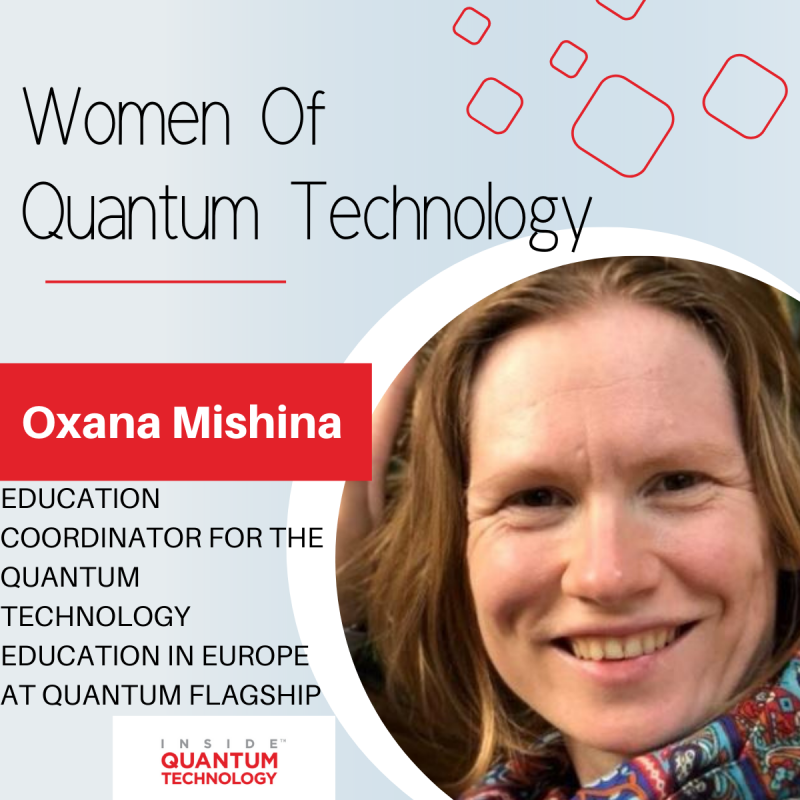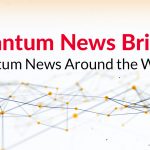Women of Quantum Technology: Dr. Oxana Mishina of QTEdu Quantum Flagship

For people like Dr. Oxana Mishina, a member of the coordination team for Quantum Technology Education in Europe for the European Quantum Flagship, explaining the quantum computing technology is easier than explaining the science. When asked about her interest in quantum technology, Mishina responded: “To me, those two words together are a little story.” This story began for Mishina during her Marie Curie fellowship at Saarland University in Germany. While studying theoretical physics, Mishina was exposed to a draft of the “quantum manifesto” within the scientific community as more and more people became interested in quantum technology. “It was really different,” she elaborated. “Like the bottom-up scientific community pushes for this technology, for something outside of the community and for the good of society. That was really attractive to me at that point.” Mishina found, through the rest of her studies (including a Ph.D.) and beyond that communicating quantum technology was far easier than communicating quantum science. “People use the technology, and they don’t always use the science,” Mishina added. “They may be curious about the science, but it’s not the kind of language I can easily use to talk to people. So, the technology has offered me a little bit more of a vocabulary to start a dialogue.”
With communication being an important part of Mishina’s career, she transitioned from quantum research to physics education research, “I wanted to dedicate my time to outreach for schools,” she explained. “So, I became a quantum ambassador for schools.” Mishina became more interested in physics education research as she did her outreach. As Mishina said: “I discovered this treasure, that there are research-based teaching methodologies out there for quantum physics.” This interest led her to connect with Italy’s Quantum Flagship for CNR-INO. “It was the right moment because the quantum flagship needed the workforce very suddenly,” Mishina stated. “Okay, but who will be doing the quantum technology, only physicists? Suddenly there was a need for novel teaching methodologies.” This allowed Mishina to help educate the incoming quantum workforce and successfully bridge the gap between industry and academia.
Mishina continues to be an Education Coordinator for the Quantum Flagship, but her job has changed over the past two years, “So, in the past two years, I’ve been a part of the coordination and support action for this European initiative, the Quantum Flagship. In the beginning, when we just came in with the education proposal, they had to create an extra coordination and support action for just the education and outreach.” Mishina helped with the Italian side of the Quantum Technology Education coordination and support action (QTEdu CSA) Quantum Flagship, working with other researchers in Denmark, Germany, and the Netherlands. From their collaboration, in two years, the team created a new community called QTEdu, which is now being further managed and supported by the new flagship coordination consortia QUCATS. Mishina now works within QUCATS and continues to coordinate this new education and outreach community. “I get to have stronger involvement,” Mishina stated. “It’s also being structured a bit better in the sense that equity, inclusivity, and diversity, which was a volunteer activity at the beginning of the flagship, is now gaining more importance.”
When looking at this equity, inclusivity, and diversity, Mishina believes it’s important we ask ourselves one question: do we even want it? “It looks obvious, but it’s not the case,” she explained. “So, apart from getting talent, you also need to really embrace diversity, which means a change of your daily routines.” The change, Mishina adds, is about work-life balance. If employers and companies can allow for more flexible work-life balances, they will hopefully retain more diverse employees, especially those who have children. “This is where the culture needs to change,” Mishima said. “It might sound obvious, but let’s not plan meetings outside of business hours or at five PM. It’s automatically less attractive for women because somebody needs to take care of the kids. Historically, it’s often women who do that,” Mishina also believes it’s a combination of bottom-up company culture and top-down company structure that will ultimately help encourage diversity. Although, diversity can’t emerge in the companies if there is no diversity along the educational path, which is what she highlights in her own work at the Quantum Flagship: “If there is an imbalanced flow, it’s really hard to balance further based on that flow,” she added. To help here, companies could engage in education and outreach activities with a long-term perspective for more diversity in the future.
Kenna Hughes-Castleberry is a staff writer at Inside Quantum Technology and the Science Communicator at JILA (a partnership between the University of Colorado Boulder and NIST). Her writing beats include deep tech, quantum computing, and AI. Her work has been featured in Scientific American, Discover Magazine, Ars Technica, and more.



















